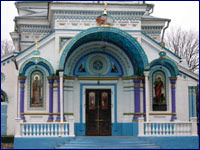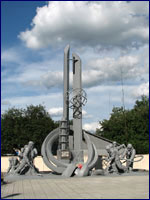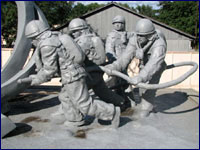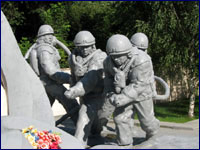| to main page |
Chernobyl town(The story about the ancient history and modern state of the Chernobyl town) The basis and existence of the city of Chernobyl is eventful history. The city was on one of the important communicative ways of the Middle Ages, on a crossroads of different cultures and religions. In the territory of the Chernobyl area, a type of culture formed in ancient times, which still attracts the views of ethnographers
In the past, these territories belonged to the Kiev Russia. In the first decades of the XII century, during the early feudal fragmentation, the Kiev Russia was comprised of 15 independent principalities, of which four - Kiev, Chernigov, Volodimiro-volynskoe and Galitskoe - remained within the limits of today's Ukraine.
Among the many cities, feudal castles and settlements that were located on the banks of the rivers Pripyat, Teterev, Irpen’ and Uzh, chronicles certify Chernobyl as one of the most significant sites.
The Liberation War of the Ukrainian people occurred between 1648-1654 and Chernobyl lands were not spared. As a result, Chernobyl repeatedly changed hands. In those years, a Kiev rebel army regiment under the command of Bogdan Khmelnitsky A. Zhdanovich visited Chernobyl, but after one month, the city was taken by a Polish-Lithuanian army by Radzwill.
When the flames of the Right Ukraine rebel movement erupted, Chernobyl was protected by the rebels twice, in 1747 and 1751. In response, the punitive detachment of a Polish gentry, headed by Matskevich, passed by fire and sword, almost across the terrain along the rivers Teterev and Pripyat.
On the territory of Chernobyl existed the three orthodox churches Illinskaya, Bogorodickaya and the Nicholas Church. Illinskaya church was built in 1749, but after a fire was rebuilt in stone and consecrated in 1878. As such, the church has survived, so far. In Chernobyl was also a Roman Catholic Church named Assumption of the sacred Virgin (built as a Dominican monastery).
In 1775, settlements of dissenters were located in Chernobyl - originating from Starodubya, as well as the Old Colony. Dissenters had their own church - St. Philip's of metropolitan Moscow. At this church was a monastery.
At the end of the XIX century, a substantial growth of a Jewish population was observed in Chernobyl. The city was considered as a family residence for the Chernobyl tsadiks, Hassidic ministers. The names of Menachem Nahum-Chernobyl and his successor Mordechai Chernobyl for their just charitable life were canonized to the Jewish rank of "holy". They were buried in Chernobyl, their grave sites built with two mausoleums.
At the turn of the XIX and XX centuries, 16,700 people lived in Chernobyl and 2,000 were around courtyards.
In 2003, Chernobyl turned 810 years old.
More detailed information about the past of the city Chernobyl can be found on the "History of Chernobyl Edge".
 Map of Chernobyl town  Satellite photo of the modern town of Chernobyl (source - Google Maps)
Literary sources:
Ipatiy annals (published 1908). Kiev annalistic code. In summer 6699 [1191] – in summer 6703[1195].
Old Chernobyl history. Article of D.Kulynnik “The secret of wolf nooks”. – “Politic and cultrura”. 1-7 may 2001. №16 (99).
|
| ||||||||||||||||
| to main page |
|
You can share your thoughts, impressions and observations with the authors of the site via Email, or leave your feedback in the Guest Book.
Materials may only be used with prior permission from www.chornobyl.in.ua. The use of direct links is required. |





















